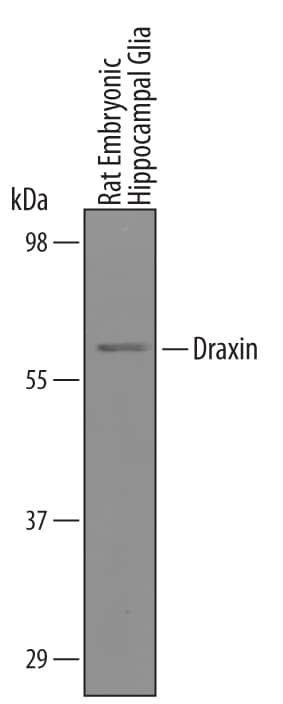Mouse/Rat Draxin Antibody
R&D Systems, part of Bio-Techne | Catalog # AF6149

Key Product Details
Species Reactivity
Validated:
Cited:
Applications
Validated:
Cited:
Label
Antibody Source
Product Specifications
Immunogen
Gly26-Ile343
Accession # Q6PAL1
Specificity
Clonality
Host
Isotype
Scientific Data Images for Mouse/Rat Draxin Antibody
Detection of Rat Draxin by Western Blot.
Western blot shows lysates of rat embryonic hippocampal glial cells. PVDF Membrane was probed with 1 µg/mL of Mouse/Rat Draxin Antigen Affinity-purified Polyclonal Antibody (Catalog # AF6149) followed by HRP-conjugated Anti-Sheep IgG Secondary Antibody (Catalog # HAF016). A specific band was detected for Draxin at approximately 58 kDa (as indicated). This experiment was conducted under reducing conditions and using Immunoblot Buffer Group 8.Draxin in Mouse Embryo.
Draxin was detected in immersion fixed frozen sections of mouse embryo (E13) using Mouse Draxin Antigen Affinity-purified Polyclonal Antibody (Catalog # AF6149) at 5 µg/mL overnight at 4 °C. Tissue was stained using the Anti-Sheep HRP-DAB Cell & Tissue Staining Kit (brown; Catalog # CTS019) and counterstained with hematoxylin (blue). Specific staining was localized to neuronal cells in the midbrain. View our protocol for Chromogenic IHC Staining of Frozen Tissue Sections.Detection of Mouse Draxin/C1orf187 by Immunohistochemistry
Draxin is expressed in midline zipper glia (MZG) and their progenitors, and associates with MZG membranes, leptomeninges, and the pial surface of the interhemispheric fissure (IHF).Schema of interhemispheric midline at E12 (A), E15 (D dorsal; G ventral) and E17 (I). In situ hybridisation for Draxin mRNA (white or green), with immunohistochemistry for astroglial marker, GLAST (red), and leptomeninges and IHF marker, Laminin (LAM; magenta) in E12 (B), E15 (E), and E17 (J) wildtype CD1 mid-horizontal telencephalic midline tissue sections. Yellow arrowheads indicate Draxin-positive/GLAST-positive glia. Open red arrowheads indicate lack of Draxin mRNA within the IHF (yellow outlined). Immunohistochemistry for DRAXIN (white or green), GLAST (red or magenta), and LAM (magenta) in E12 (C), E15 (F), and E17 (K) wildtype CD1 mid-horizontal telencephalic midline tissue sections. (H) DRAXIN (white or green), axonal marker GAP43 (red), and LAM (magenta) in E15 ventral telencephalic midline tissue sections. Yellow arrowheads indicate regions of DRAXIN protein on GLAST-positive glial fibres (C, F, K) or DRAXIN protein on GAP43-positive axons (H’). White arrowheads indicate DRAXIN protein within the IHF and on the basement membrane of the IHF. BM: basement membrane; CCx: cingulate cortex; IGG: indusium griseum glia; LM: leptomeninges; MZGp: midline zipper glia progenitors; Se: septum; Th: telencephalic hinge; 3V: third ventricle. Image collected and cropped by CiteAb from the following open publication (https://pubmed.ncbi.nlm.nih.gov/33945466), licensed under a CC-BY license. Not internally tested by R&D Systems.Applications for Mouse/Rat Draxin Antibody
Immunohistochemistry
Sample: Immersion fixed frozen sections of mouse embryo (E13)
Western Blot
Sample: Rat embryonic hippocampal glial cells
Formulation, Preparation, and Storage
Purification
Reconstitution
Formulation
Shipping
Stability & Storage
- 12 months from date of receipt, -20 to -70 °C as supplied.
- 1 month, 2 to 8 °C under sterile conditions after reconstitution.
- 6 months, -20 to -70 °C under sterile conditions after reconstitution.
Background: Draxin
Draxin (Dorsal repulsive axon guidance protein; also neucrin) is a secreted, 58 kDa, presumable glycoprotein member of the Draxin family of molecules. In mammals, it is expressed in neurons (axons), astroglia, and likely cells of the developing somite. Draxin acts as a Wnt antagonist, apparently by binding to LRP6. The net effect is to block neural crest migration, and the organization of axons into functional tracts or bundles (fasciculation). Mature mouse Draxin is 318 amino acids (aa) in length. It contains one potential N-linked glycosylation site, followed by a Cys-rich domain (aa 268-327). Mature mouse Draxin (aa 26-343) shares 80% aa identity with mature human Draxin, and 94% aa identity with mature rat Draxin.
Long Name
Alternate Names
Gene Symbol
UniProt
Additional Draxin Products
Product Documents for Mouse/Rat Draxin Antibody
Product Specific Notices for Mouse/Rat Draxin Antibody
For research use only




